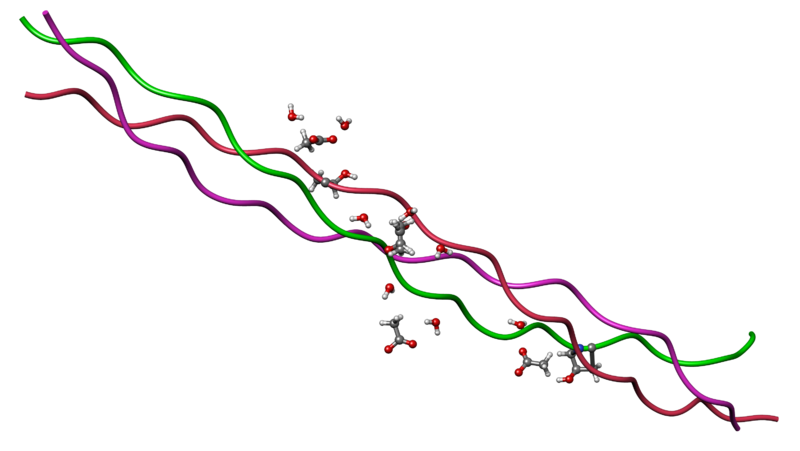The 5 Essential Roles of Proteins in Cellular Function
Proteins are the powerhouse molecules that drive almost every biological process in the body. These "workhorses" perform countless functions, from structural support to enabling movement.
In this blog, we’ll focus on five critical proteins—collagen, elastin, keratin, actin, and tubulin—and explore the essential roles they play in cellular and tissue function.
1. Collagen: The Body’s Structural Framework
Collagen Triple Helix
MarinaVladivostok, CC0, via Wikimedia Commons
Collagen is the most abundant protein in the human body, making up around 30% of its total protein content. Known for its strength and stability, collagen forms the framework of connective tissues such as bone, skin, tendons, and cartilage.
Structure: Collagen is organized in a triple-helix structure that gives it remarkable tensile strength, allowing tissues to withstand stretching and pressure.
Wound Healing: Beyond providing strength, collagen is essential for wound healing. When injuries occur, collagen fibers are deposited in the area to help recruit cells necessary for tissue repair. This process facilitates cellular communication and adhesion.
Example: Defects in collagen, such as those seen in Ehlers-Danlos syndrome, can lead to tissue fragility and impaired healing.
2. Elastin: Providing Flexibility and Recoil
While collagen provides strength, elastin supplies tissues with the flexibility they need to stretch and return to their original shape. This stretchy protein is found in tissues that experience frequent stretching, such as the lungs, arterial walls, and skin.
Elasticity: Elastin’s unique coiled structure allows it to act like a rubber band, expanding and contracting with movement.
Clinical Importance: In conditions like emphysema, the degradation of elastin reduces lung function, impairing the ability of the lungs to expand and contract.
Fun Fact: Elastin is crucial for normal lung function. Without elastin, the alveoli in the lungs lose their elasticity, making breathing more difficult.
3. Keratin: The Body’s Protective Barrier
Keratin is the protein responsible for the structure and strength of skin, hair, and nails. Acting as a protective barrier, keratin helps the body resist physical damage, pathogens, and water loss.
Structure: Keratin fibers are organized in alpha-helical structures that interlink to form strong fibers, ensuring a resilient layer against environmental hazards.
Clinical Example: In conditions like epidermolysis bullosa, mutations in keratin weaken the skin, causing it to tear easily. This highlights keratin's essential role in the structural integrity of epithelial tissues.
Fun Fact: Keratin’s strength helps protect the skin and underlying tissues from environmental damage, water loss, and infections.
4. Actin: Facilitating Movement and Contraction
Actin plays a vital role in muscle contraction, cell movement, and cell division. As a component of microfilaments in the cytoskeleton, actin provides support and enables cellular movement.
Muscle Contraction: In muscle cells, actin interacts with myosin to produce the force required for muscle contraction. This interaction is regulated by calcium ions and ATP, making it essential for physical movement.
Cell Division: Actin also plays a major role in cell division, forming the contractile ring that separates two daughter cells during mitosis.
Clinical Significance: Actin’s role in cellular movement is critical for processes such as wound healing and immune response.
5. Tubulin: The Cell’s Internal Highway
Tubulin is the building block of microtubules, which form the structural framework of the cell. These microtubules act as highways, allowing the transport of organelles, vesicles, and other cellular components.
Intracellular Transport: Microtubules enable the efficient movement of cellular cargo, ensuring that essential molecules reach their destinations within the cell.
Role in Cell Division: During mitosis, tubulin forms the mitotic spindle, which is necessary for the proper separation of chromosomes.
Clinical Connection: In diseases like Alzheimer’s, disruptions in tubulin dynamics affect intracellular transport, leading to cell dysfunction.
**Therapeutic Applications: Tubulin in Cancer Treatment
Tubulin also plays a crucial role in cancer therapy. Drugs like paclitaxel target tubulin to stabilize microtubules and prevent cancer cells from dividing. By interfering with cell division, these treatments help to slow or stop the spread of cancer.
Learn More with King of the Curve!
Proteins like collagen, elastin, keratin, actin, and tubulin are foundational to cellular function. Each has a unique role that supports the body’s structure, movement, and internal transport systems. Understanding these proteins is essential for mastering concepts in biology and physiology.
For more in-depth explorations of these topics, try our roadmap feature in the King of the Curve app!
Our resources are designed to help you understand complex biological concepts and enhance your learning journey. Download the app or visit kingofthecurve.org for a wealth of content that will deepen your knowledge.
-
King of the Curve combines serious, exam-level content with a gamified and engaging platform—striking a balance that no other tool has achieved.
Our content matches the difficulty of real exams, ensuring you’re thoroughly prepared. What sets us apart is that students enjoy using KOTC even when they’re not under the immediate pressure of a looming exam. This makes us a powerful long-term tool for memory retention, helping students stay proactive in their preparation and excel in their coursework well before test day.
-
Gamification is designed to evoke a strong emotional response, enhance memory retention, and make studying more enjoyable. Our platform achieves these goals with colorful designs, in-game challenges, and social leaderboards.
The platform is structured so there's always a new goal to strive for by completing challenges with exclusive rewards. While the leaderboards let you compete against other students at your school and track your friends' activity, making it a fun way to stay accountable.



